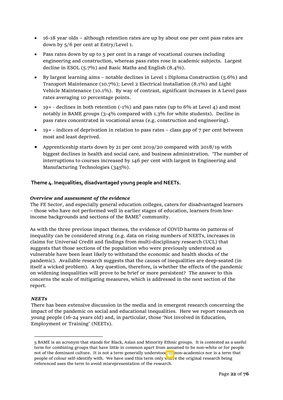
Page 22 of 76
• 16-18 year olds - although retention rates are up by about one per cent pass rates are
down by 5/6 per cent at Entry/Level 1.
• Pass rates down by up to 5 per cent in a range of vocational courses including
engineering and construction, whereas pass rates rose in academic subjects. Largest
decline in ESOL (5.7%) and Basic Maths and English (8.4%).
• By largest learning aims - notable declines in Level 1 Diploma Construction (5.6%) and
Transport Maintenance (10.7%); Level 2 Electrical Installation (8.1%) and Light
Vehicle Maintenance (10.1%). By way of contrast, significant increases in A Level pass
rates averaging 10 percentage points.
• 19+ - declines in both retention (-1%) and pass rates (up to 6% at Level 4) and most
notably in BAME groups (3-4% compared with 1.3% for white students). Decline in
pass rates concentrated in vocational areas (e.g. construction and engineering).
• 19+ - indices of deprivation in relation to pass rates - class gap of 7 per cent between
most and least deprived.
• Apprenticeship starts down by 21 per cent 2019/20 compared with 2018/19 with
biggest declines in health and social care, and business administration. 'The number of
interruptions to courses increased by 146 per cent with largest in Engineering and
Manufacturing Technologies (345%).
Theme 4. Inequalities, disadvantaged young people and NEETs.
Overview and assessment of the evidence
The FE Sector, and especially general education colleges, caters for disadvantaged learners
- those who have not performed well in earlier stages of education, learners from lowincome
backgrounds and sections of the BAME5
community.
As with the three previous impact themes, the evidence of COVID harms on patterns of
inequality can be considered strong (e.g. data on rising numbers of NEETs, increases in
claims for Universal Credit and findings from multi-disciplinary research (UCL) that
suggests that those sections of the population who were previously understood as
vulnerable have been least likely to withstand the economic and health shocks of the
pandemic). Available research suggests that the causes of inequalities are deep-seated (in
itself a wicked problem). A key question, therefore, is whether the effects of the pandemic
on widening inequalities will prove to be brief or more persistent? The answer to this
concerns the scale of mitigating measures, which is addressed in the next section of the
report.
NEETs
There has been extensive discussion in the media and in emergent research concerning the
impact of the pandemic on social and educational inequalities. Here we report research on
young people (16-24 years old) and, in particular, those 'Not involved in Education,
Employment or Training' (NEETs).
5 BAME is an acronym that stands for Black, Asian and Minority Ethnic groups. It is contested as a useful
term for combining groups that have little in common apart from assumed to be non-white or for people
not of the dominant culture. It is not a term generally understood by non-academics nor is a term that
people of colour self-identify with. We have used this term only where the original research being
referenced uses the term to avoid misrepresentation of the research.